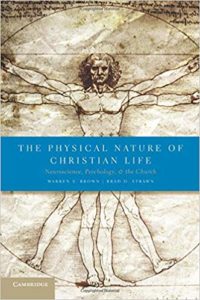
The Physical Nature of Christian Life: Neuroscience, Psychology, and the Church
Reviewed by William M. Struthers, Psychology, Wheaton College
When evangelical theologians and scientists come to the table to dialogue, it is not uncommon for sparks to fly. The topic may be cosmology, human origins, or morality, but for quite some time there has been considerable push and pull between these two camps which can be contentious. Theologians have found themselves performing hermeneutical gymnastics, targeting philosophical/methodological issues, or adopting a defensive posture of non-overlapping magisteria when challenged by scientists. While there have been a handful of particularly contentious issues (most notably a historical Adam), one area that has shown promise of discourse is on the issue of human nature. In their book, The Physical Nature of Christian Life: Neuroscience, Psychology, & the Church, authors Warren Brown and Brad Strawn unpack recent findings in neuroscience and challenge contemporary theologians to stop, do a bit of historical reflection, and envision a richer view of human nature to be recovered.
Brown is a highly regarded neuropsychologist who teaches Graduate Psychology at Fuller Theological Seminary. In this book he reprises his position of a “physicalist” view of persons about which he has written extensively. He is joined by Strawn, who adds the “high touch” voice of a practicing psychologist and clergyman. While it may appear to be a small book at first blush, The Physical Nature of Christian Life is a concise, dense, and creative interdisciplinary text that is accessible regardless of the reader’s background. The flow of the text is straightforward and easy to read, and its arguments are coherent and convincing.
Their major claim is that our modern view of human beings is heavily influenced by Hellenic thought, resulting in a modern-day Gnosticism that permeates Western Christian traditions. The book has two sections that are more than a tad unbalanced. The first three chapters (Part 1) unpack a distinctively Wesleyan perspective on human nature which is clear, well-balanced, and convincing. The second section of the book (Part 2 – which actually includes the last seven chapters) begins with relevant research in psychology and neuroscience and provides the foundation for their arguments about the importance of embodiment. By focusing on relationship and transformation they switch theological and scientific voices throughout the remaining chapters to argue for a dynamic and open view of embodied persons who work within social contexts (here is where they bring in the church).
The arguments that they present provide support for both theologians and scientists to have meaningful dialogue about human nature in a way that honors both theological and scientific traditions and systems. For theologians looking to defend a contemporary view of the soul as a ghost in the machine, they will find this book either maddening or enlightening. Neuroscientists who are looking for a beat-down of religion will be either unsatisfied with the sympathies shown by the authors or appreciative of the theological nuance. The true beauty of this book is that Brown and Strawn weave psychology throughout the theology and neuroscience to bridge the gap between these two very specialized disciplines. At times the theological language is embedded so close to the scientific that the transitions can feel abrupt. When taken as a whole, however, there is a mixture of hypothetical examples, accessible spiritual language, informative theology, and contemporary science. It is perhaps the best current treatment of interpersonal neurobiology available. It covers attachment theory, empathy, narrative, and self-organizing systems/complex dynamical systems. It also finds a way to be relevant and ends with view of a Christian life that is anchored in wisdom, virtue, and science.
Brown and Strawn have also offered a solid scholarly argument that should challenge those who see faith and science as incompatible. The notion that embodied persons are embedded in social contacts is one that many will find challenging, but others will find intuitive. For those who look between the theological lines, the influence of their Wesleyan theological perspective is clear. Much attention is given to relationality, dynamic systems, open development, and process; this is sorely absent in texts attempting to address these issues from a Reformed perspective.
One area where the book could be improved upon is that it feels rather one-sided. It seems as though the majority of the concessions that are to be made in the dialogue between theology and science are made by theologians who are forced to reinterpret their perspectives within the light of scientific research. This is beneficial and necessary, but there seems to be little pushback in the opposite direction. The concluding chapter about what the church may look like after abandoning a Gnostic and dualistic notion of humanity is helpful, but I am left with the impression that there is much more work to be done in this area. Christians in neuroscience and psychology will need to be willing to do more than just reinterpret Scripture based on the available science of the day. They need to be able to translate complex and theological implications that science has for the way that we live out our faith in this day and age.
Overall, for those who are looking for a little bit of this and a little bit of that, they will be delighted. For those who are looking for a deep treatment of a pet theological or scientific topic, they will find themselves wanting. There is just enough to paint the picture that they are crafting, but not so much that their broader thesis is lost in the details. Too often books of this nature either stray too far to the extremes of providing too much detail, or oversimplifying the background information. In light of this, I highly recommend this text to those who are looking for a synthesis of theology, neuroscience, and psychology. It is one of the better books out there in this area due to its academic rigor, flow of text, and its scope.























